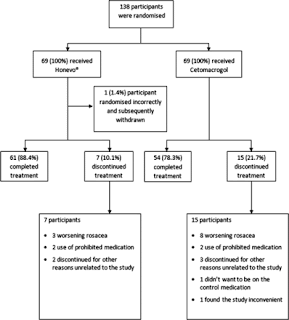Randomised controlled trial of topical kanuka honey for the treatment of rosacea
BMJ Open. 2015 Jun 24;5(6):e007651
OBJECTIVE:
To investigate the efficacy of topical 90% medical-grade kanuka honey and 10% glycerine (Honevo) as a treatment for rosacea.
DESIGN:
Randomised controlled trial with blinded assessment of primary outcome variable.
SETTING:
Outpatient primary healthcare population from 5 New Zealand sites.
PARTICIPANTS:
138 adults aged ≥16, with a diagnosis of rosacea, and a baseline blinded Investigator Global Assessment of Rosacea Severity Score (IGA-RSS) of ≥2. 69 participants were randomised to each treatment arm. 1 participant was excluded from the Honevo group, and 7 and 15 participants withdrew from the Honevo and control groups, respectively.
INTERVENTIONS:
Participants were randomly allocated 1:1 to Honevo or control cream (Cetomacrogol), applied twice daily for 8 weeks.
MAIN OUTCOME MEASURES:
The primary outcome measure was the proportion of participants who had a ≥2 improvement in the 7-point IGA-RSS at week 8 compared to baseline. Secondary outcomes included change in IGA-RSS and subject-rated visual analogue score of change in severity (VAS-CS) on a 100 mm scale (0 mm 'much worse', 100 mm 'much improved') at weeks 2 and 8.
RESULTS:
24/68 (34.3%) in the Honevo group and 12/69 (17.4%) in the control group had a ≥2 improvement in IGA-RSS at week 8 compared to baseline (relative risk 2.03; 95% CI 1.11 to 3.72, p = 0.020). The change in IGA-RSS for Honevo compared to control at week 2 minus baseline was -1 (Hodges-Lehman estimate, 95% CI -1 to 0, p=0.03), and at week 8 minus baseline was -1 (Hodges-Lehman estimate, 95% CI -1 to 0, p = 0.005). The VAS-CS at week 2 was 9.1 (95% CI 3.5 to 14.7), p = 0.002, and at week 8 was 12.3 (95% CI 5.7 to 18.9)¸ p < 0.001 for Honevo compared to control.
CONCLUSIONS:
Honevo is an effective treatment for rosacea.


















